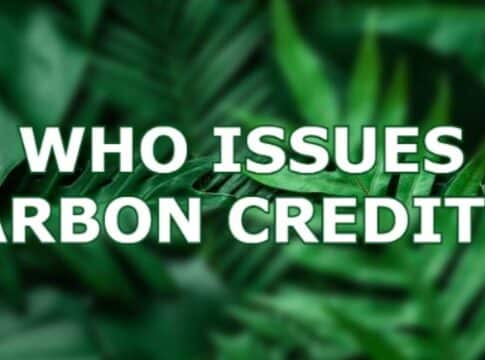Who Issues Carbon Credits? (Everything You Need To Know)
Who issues carbon credits? A question that requires a not-so-straightforward answer… Still, it deserves an answer.
Primarily because slashing emissions and decarbonizing economies are urgently required. But the time is running out and the technology to do that is not always readily available.
Enter carbon credits…
Individuals and companies buy them to compensate for their unavoidable emissions. They’re from projects or activities that reduce or remove carbon emissions from the air.
How do carbon credits work? And how do they work for farmers or landowners? If you also have the same questions, then let’s get to the bottom of them after we deal with the basics first.
How Do Carbon Credits Work and Who Issues Them?
Carbon credits work like most commodities – they’re tradable units or certificates. To be more specific, they are a permit that gives its holder the right to emit certain amounts of carbon dioxide or its equivalent (CO2e), such as nitrous oxide, methane, etc.
1 carbon credit represents 1 metric tonne of CO2 prevented from entering the atmosphere.
Why do we need carbon credits, or to put it more appropriately… Can we go about without them?
If people and companies continue their business as usual, then there’s no place for carbon credits. But if we bravely accept the truth and face the climate crisis head-on, then carbon credits are critical.
Fast Fact: The world has seen billions of metric tonnes (Mt) of CO2e pumped into the air each year, rising from about 36 billion Mt in 2016 to around 41 billion Mt in 2022.
That scary fact gave birth to carbon credits; they came about to tackle the need for controlling harmful GHG emissions. They’re particularly meant to slash carbon emissions from industrial activities in carbon-intensive sectors such as steel, power, transportation, and other industries that use fossil fuels.
Be it coal, oil, or natural gas, they all release detrimental gasses into our atmosphere. They just don’t pollute the air we breathe but they also trap heat from the sun. In other words, they’re the ones to blame for the earth’s rising temperatures.
So, if we want to stop the planet from getting warmer, we need to have some solutions up our sleeves. And yes, carbon credits are one of them.
How Do Carbon Credits Work?
Carbon credits are traded in carbon markets, voluntarily (voluntary carbon market) and mandatory (compliance market).
To help you understand better how these credits work, here’s a sample scenario where they’re used.
In a regulated market, if a country limits how much carbon companies can emit, then those firms have to abide by the law. So if the government permits company A to release only 100 Mt of CO2e each year, but the latter emits 200 Mt it has to compensate for the excess of 100 Mt.
Company A then buys 100 carbon credits to fully offset the excess. Or it may decide to just pay the fine, which can be more expensive.
In the VCM, the concept is pretty much the same. The only difference is that company A does it voluntarily for good reasons. It can be that stakeholders pressure it or the officers want to do it as part of its ESG practice.
Regardless of the reason, one big question rises – who issues carbon credits and does America issue them, too?
The Kyoto Protocol establishes the carbon credit system. It put in place quotas on how much GHG countries can dump into the air. But only developed countries, known for their huge GHG emissions, have certain emissions limits or caps to meet.
They operate in an emissions trading system, popularly known as ETS. Carbon credits traded in an ETS are from various projects certified and verified by carbon standards such as Verra, Gold Standard, Puro.earth, American Carbon Registry, among others.
For developing nations, carbon credits are issued in the form of Certified Emission Reductions (CERs). Each CER is awarded for each tonne of GHG that a project reduces, avoids, or removes. These carbon credits, measured in Mt of CO2e, are issued by UNFCCC.
Anyone can buy these carbon credits on this platform to offset their emissions. Or they can do so just to support or finance the carbon reduction or removal projects.
Here’s how the platform looks when searching for a specific project, where it is, and other information about it.
Credit buyers and sellers can also trade in carbon exchange platforms. They work like a stock exchange for carbon credits.
How Do Carbon Credits Work In America?
While the carbon credits system has been around in the EU, China, Australia, New Zealand, and South Korea, it’s not available on the same scale in the United States. But California has its own ETS operating since 2012 and it covers the state of California only.
Emissions standards are set by the California Air Resources Board (CARB).
In a sense, how carbon credits work in America follow the same system that exists in the California ETS. However, entities that want to offset their carbon footprint in other parts of America won’t be covered by the California ETS.
The California carbon credits system covers several sectors, which includes:
Large industrial facilities (e.g. cement, iron and steel, petroleum refining, hydrogen, etc.)
Electricity generation and electricity imports
Suppliers of carbon dioxide
Suppliers of natural gas, petroleum gas, LNG, LPG, and certain distillate fuel oils
Other stationary combustion
The current price for carbon under the California ETS is USD ~$30 per ton. The carbon trading system has collected $14+ billion since inception, which includes $1.7 in 2020 alone.
Apart from those regulated sectors, any business entity or individual can take part in trading carbon credits voluntarily. Same as explained earlier, entities can either buy or sell carbon credits or do both, in the VCM.
You can do the same through different carbon credit marketplaces and carbon exchanges. There are plenty of them available, each has a set of unique features but offers almost the same benefits of trading carbon credits.
If you want to know the details of how to buy carbon credits, here’s our step-by-step guide to do that.
Basically, that’s how carbon credits work in America, which is pretty much the same in other parts of the world.
If you’re wondering who is the largest seller of carbon credit, it’s currently China and India. While the largest buyer of carbon credit is usually the countries in Europe.
But it’s interesting to note that Tesla is also one of the biggest sellers of carbon credits under CARB. In fact, it earned billions of dollars already from doing it. Its 2022 total carbon credit sales shows that the electric carmaker made a record $1.78 billion.
In the VCM, the biggest buyer of carbon offset credits is the crypto trading company Toucan Protocol, according to Bloomberg. Toucan is a bridging protocol that turns real-life carbon credits into tokens that can be used on a blockchain. It was the first platform to allow for the tokenization of carbon credits.
The data analyzed is from Verra, the world’s largest carbon standard. But since data that’s available is limited to what carbon credit buyers and sellers voluntarily disclose, the analysis covers only about half of the global carbon market.
Source: BloombergNEF
Farmers and any landowners can also sell carbon credits because all land can store carbon. So, this makes farmers eligible for earning carbon credits with 1 credit for each ton of CO2 their land sequesters.
How Do Carbon Credits Work For Farmers?
The idea is simple. If you’re a farmer, prove that your land reduces or removes more carbon than it previously did. But how does that happen? By making some changes in your farming practices, usually with sustainable and regenerative farming.
The reduction or sequestration of CO2 by regenerative farming leads to the creation of carbon credits. These credits are then brought to market by project developers who sold them to companies that need to offset their own emissions while supporting farmers.
In return, farmers get extra revenue for every ton of CO2 sequestered by their farmlands.
For instance, if a farmer has a total amount of sequestered GHG of 22,745 metric tons across his acres, he can earn carbon credits worth $341,175 with the price of $15/ton.
Apparently, how carbon credits work for farmers is quite similar to how they do for others who can show they reduce or remove CO2.
There’s a catch, however. Farmers may falsely claim, intentionally or with an honest mistake, to achieve certain carbon reductions or removal.
This is where an independent, 3rd-party body comes in to measure and verify the carbon reduction claim. This is to ensure that there’s a real carbon reduction or sequestration that happens.
Soil tests, for example, are one way of carbon credit programs to verify claims. In the US, validation of farming practices is done by way of federal crop records and field data.
On the buyers’ side, investors and businesses like Cargill, General Mills, Mcdonald’s, Shopify, Microsoft, and JPMorgan are committed to supporting farming methods that regenerate the soil to capture more carbon.
They buy carbon credits from farmers, incentivizing them to continue their farm’s carbon sequestration. They specifically aim to advance regenerative farming practices on millions of acres of North American lands.
The chart below shows the potential of various regenerative farming methods in cutting emissions in million metric tons of CO2e.
The Growing Climate Solutions Act of 2021 gives authority to the U.S. Department of Agriculture (USDA) to help farmers, ranchers, and forest landowners take part in carbon credit markets. It supports the development of a voluntary market for carbon credits on agricultural lands.
Fast Fact: A study indicated that the potential demand for agriculture carbon credits in the US is 190 million tons per year. It also estimated the size of the US market for carbon credits at $5.2 billion per year.
How Do Carbon Tax Credits Work?
Governments do love taxes. Understandably so because they bring in revenue and they’re easy to administer, at least in theory. Taxes are also a great tool to control purchasing power.
If the government raises the tax on something, the price also increases. With increased prices, fewer people can buy that item or use the service. Adopting the same concept to pricing carbon makes sense.
Carbon tax credits are the government’s tool to incentivize initiatives that prevent or remove carbon from the atmosphere.
In the U.S., Pres. Biden’s 45Q tax credit is a perfect example. It particularly incentivizes carbon capture and storage (CCS) projects. Heavy industries like steel and cement where decarbonization is challenging are covered with this carbon tax.
Projects that capture carbon enjoy the benefit of $85 per metric ton.
Direct air capture (DAC), in particular, is a popular carbon removal technology that removes carbon and stores it geologically. It’s badly needed for the world to decarbonize. Fortunately, it’s scalable with the right investments and funding.
Enhancing the existing carbon tax credit for carbon sequestration can speed the deployment and innovation of CCS technologies.
And that’s how carbon tax credits work to help companies race towards net zero.
Carbon credits are for entities to offset their emissions and support carbon reduction/removal efforts. Carbon tax credits are to further incentivize those climate-related actions and encourage carbon reductions.
Issuing Carbon Credits
Who issues carbon credits depends on two things: mandated or voluntary. But regardless of which market, issuing carbon credits follow the same principles.
The issuer must know all the important information about them, the project that generates the credits, its location, vintage, benefits/co-benefits, and more. This information should then be publicly available for the buyers or investors to access and evaluate.
Only when there’s transparency that the integrity of the credits can be verified. After all, the credits must show that they have indeed done their job of cutting or preventing carbon emissions.
If you want to know more about carbon credits, visit our comprehensive guide here. Or you can go over this article on who verifies carbon credits prior to issuance.
The post Who Issues Carbon Credits? (Everything You Need To Know) appeared first on Carbon Credits.



